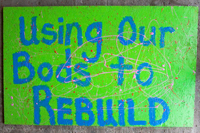Students donate spring break, sweat to aid Greensburg
March 31, 2008
At approximately 2:30 p.m. March 16 about 50 Washburn students left campus for a six-day service trip to Greensburg, Kan.
On May 4, 2007, Greensburg was hit by one of the worst tornados on record. It was ranked an EF-5 on the Enhanced Fujita Scale, the most severe classification possible, and it was the first EF-5 since the new scale was introduced in February of the same year. The tornado destroyed approximately 95 percent of the town of 1,500-1,600 people.
Washburn was not the only school to send students to help with the rebuilding of Greensburg. Approximately 350 students came from schools such as the University of North Dakota, Fort Hays State University and the University of Kansas School of Architectural Engineering, among others. So many students spent their spring breaks in Greensburg that a sign was placed along the highway running through town proclaiming it “The New Cancun.”
Projects that Washburn students were involved in ranged from picking up debris to gutting a house to check for mold, breaking dirt clods so a yard could grow back, and roofing a house for a man named Ferrell Allison. Allison and his wife lost a farmhouse, which was more than 100 years old, and which they had put considerable time into renovating.
The students who worked on the roof will almost certainly watch the Discovery Channel in July to see if the footage taken of them will be used in the 13-part miniseries “Eco-Town,” hosted by Leonardo DiCaprio. Camera crews were filming all across the town and it was said that if the series is popular its run might be extended. The name of the series stems from the idea of a “green Greensburg” that will be rebuilt to be energy-efficient, using environmentally friendly materials and techniques.
Volunteers were extremely well taken care of in Greensburg. Two meals daily were provided in “Volunteer City,” which in addition to the dining hall also contained living quarters for extended stay volunteers and served as a headquarters for the volunteer coordinators.
When they weren’t working in Greensburg or entertaining themselves in the nearby town of Pratt, students stayed in the gymnasium of Haviland High School, which has an average graduating class of around 12. Students also got to witness the construction of the new pressurized water tower located adjacent to the world’s largest hand-dug well, a landmark synonymous with Greensburg before it was superseded by the tornado.
It was a trip that the students aren’t likely to forget soon, from the conversations with citizens about where they were when the tornado struck to the extent of the damage still left after 10 months.
“The trees were totally stripped and the buildings were gone and debris was still everywhere,” said Kate Rowden, a sophomore nursing major.
The rebuilding process serves as a stark reminder of how much easier it is to tear down than to build, but it also is a testament to the commitment of the people who live in Greensburg and those that come to help.
Editor’s Note: in the interest of full disclosure, Kyle Volle was a participant in the alternative spring break trip to Greensburg, Kan.



